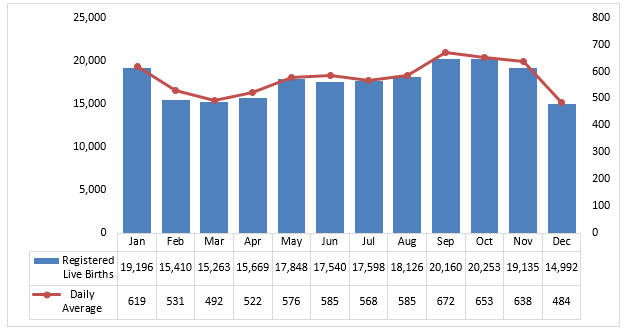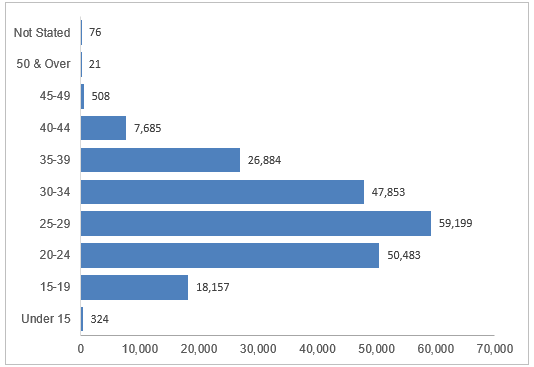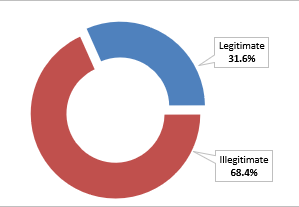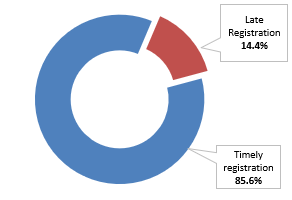This special release presents data on births obtained from the timely and late registered births at the Office of the City/Municipal Civil Registrars and submitted to the Office of the Civil Registrar General through the Philippine Statistics Authority - Provincial Statistical Offices (PSA - PSOs). Information presented includes registered births that occurred from January to December 2020 (cut-off date is as of 16 July 2021 on the submission of encoded data files to the PSA-Central Office from PSOs). Figures presented herein are not adjusted for under registration.
Fourteen births per thousand population
In 2020, a total of 211,190 live births were registered in National Capital Region (NCR) which translate to an average of around 577 babies born daily or 24 babies born per hour. The number of registered live births to mothers with usual place of residence is in NCR reached 198,981 which is equivalent to a crude birth rate (CBR) of 14.4 or around 14 births per thousand population.1
The number of registered live births from 2011 to 2020 showed a generally decreasing trend. The highest decline rate was noted in 2020 with 12.9 percent. (Figure 1 and
Figure 1. Number of Registered Live Births, NCR: 2011 – 2020
(in ’00,000)

Figure 2. Percent Change of Registered Live Births, NCR: 2011 - 2020

More male babies were born than female
There were more male babies born (109,899 or 52.0%) than female babies (101,291 or 48.0%) in 2020 resulting in a sex ratio at birth of 108 males per 100 females. City of Makati posted the highest sex ratio with 112 males per 100 females, while Pasay City and Pateros both posted sex ratios of 104 males per 100 females
Figure 3. Percent distribution of Registered Live Birth by Sex, NCR: 2020

More than half of the registered live births occurred in three cities of NCR
City of Manila registered the most number of live births with 48,208 followed by Quezon City with 47,715 and City of Caloocan with 19,768. The combined registered live births of these three cities comprised 54.8 percent of the total live births in NCR. Meanwhile, Pateros reported the least number of live births with 1,317 followed by City of San Juan with 1,718. (Figure 4)
Figure 4. Number of Registered Live Births by City/Municipality of Place of Occurrence and by Usual Residence of Mother, NCR: 2020

Births occurred in NCR exceeds births to mothers residing in the region
Registered births that occurred in NCR exceeded births to mothers residing in the region by 12,209. Five cities and Pateros reported more registered births than births from mothers residing in the respective cities/municipality. City of Manila posted the largest difference between registered births and birth to mothers residing in the city by 20,833 which is 43.2 percent of the births occurred in the city. This may be due to expectant mothers residing outside the city giving birth at Dr. Jose Fabella Memorial Hospital, the National Maternity Hospital located in Santa Cruz, Manila.
On the other hand, City of Caloocan with 19,768 registered births and 26,524 births from mothers residing in the city topped among the 11 cities that reported lesser resgistered births than births from its residents. (Figure 4)
Most number of births registered in October
In 2020, most registered births occurred in October with 20,253 followed by the months of September (20,160), January (19,196), and November (19,135). On the other hand, the month of December had the least number of births with 14,992.
In terms of daily average, September recorded the highest with an average of 672 births per day, which translates to 28 births per hour. Conversely, December had the lowest daily average number of births with 484, equivalent to 20 births per hour. (Figure 5)
Figure 5. Number and Daily Average of Registered Live Births by Month of Occurrence,NCR: 2020

Near to 100 percent of all birth deliveries in NCR were medically attended and delivered in health facilities
Of the total number of births in NCR, 97.0 percent were attended by health professionals (physician, midwife, or nurse). Ten of the 17 cities/municipality reported equal or higher than the region’s percentage of births attended by health professionals with City of Makati (99.6%) leading the list followed by City of Mandaluyong (99.5%) and City of San Juan (99.4%).
In terms of place of delivery, 96.2 percent of births in NCR were delivered in health facility (either hospital, birthing clinic, lying in, outpatient care center, specialized care center, and the like), 3.6 percent were delivered at home, and the remaining 0.2 percent or 432 births were delivered in other locations.
Figure 6. Percent Distribution of Registered Live Births by Attendant at Birth, NCR: 2020

Figure 7. Percent Distribution of Registered Live Births by Place of Delivery, NCR: 2020

Majority of babies were born to mothers aged 25-29 years old
Majority of registered live births occurred in NCR were born to mothers aged 25-29 years with 59,199 or 28.0 percent followed by aged 20-24 years (50,483 or 23.9%) and aged 30-34 (47,853 or 22.7%). Babies born to adolescent mothers (aged 15-19) reached 18,157 or 8.6 percent while there were 324 babies born to mothers who are less than 15 years of age. Meanwhile, babies born to high risk pregnancy due to older age of mother (35 and over) comprised 35,098 or 16.6 percent of the total registered births in 2020.
Figure 8. Number of Registered Live Births by Age Group of Mother, NCR: 2020

Two in every three babies were born to unwed mothers
Of the total 198,981 registered live births to mothers residing in the region, 136,028 or 68.4 percent were born out of wedlock. This translates to two in every three babies born to unwed mothers residing in NCR in 2020. Among regions, NCR has the highest percentage of babies born to unwed mothers followed by Eastern Visayas with 66.9 percent and CALABARZON with 61.5 percent.
Figure 9. Percent Distribution of Registered Live Births by Legitimacy Status, NCR: 2020

About 86 percent were registered on time
Timely registration refers to registration of the birth within 30 days of occurrence. In 2020, 85.6 percent of live births to mothers residing in NCR were registered on time while 14.4 percent were registered late. NCR ranks 6th among 17 regions with high number of late registered births in 2020.
Figure 10. Percent Distribution of Registered Live Births by Legitimacy Status, NCR: 2020

PACIANO B. DIZON
Regional Director
Explanatory Note
Data on births presented in this release were obtained from the timely and late registered births at the Office of the City/Municipal Civil Registrars all throughout the country and submitted to the Office of the Civil Registrar General through the Philippine Statistics Authority (PSA)-Provincial Statistical Offices (PSOs). Information presented includes registered births that occurred from January to December 2020 (cut-off date is as of 16 July 2021 on the submission of encoded data files to the PSA-Central Office from PSOs). Figures presented herein are not adjusted for under registration. Births of Filipinos abroad which were reported to the Philippine Foreign Service Posts are presented in a separate report.
Technical Notes
Vital statistics are derived from information obtained at the time when the occurrences of vital events and their characteristics are inscribed in a civil register.
Vital acts and events are the births, deaths, fetal deaths, marriages, and all such events that have something to do with an individual's entrance and departure from life together with the changes in civil status that may occur to a person during his lifetime. Recording of these events in the civil register is known as vital or civil registration and the resulting documents are called vital records.
Livebirth is a complete expulsion or extraction from its mother of a product of conception, irrespective of the duration of the pregnancy, which after such separation, breathes or shows any other evidence of life, such as the beating of the heart, pulsation of the umbilical cord, or definite movement of the voluntary muscles, whether or not the umbilical cord has been cut or the placenta is attached: each product of such a birth is considered live born.
Crude Birth Rate (CBR) refers to the number of live births per 1,000 mid-year population.
Sex Ratio refers to the number of males per one hundred females.
Usual Residence refers to the place where the person habitually or permanently resides.
Place of Occurrence refers to the place where the vital event took place.
